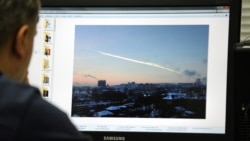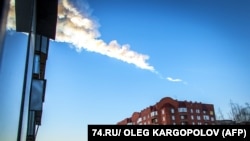Black smoke rises from a factory following sightings of a falling object in the sky in the Urals city of Chelyabinsk (photo by RIA Novosti):
This factory/warehouse door never had a chance:
On the terminology -- meteor vs meteorite -- via NASA:
Meteor -- Any of the small particles of matter in the solar system that are directly observable only by their incandescence from frictional heating on entry into the atmosphere.
Meteorite -- A meteor that reaches the surface of the earth without being completely vaporized.
So, if the object is visible, it is a meteor. When and if it makes physical contact with the Earth it becomes a meteorite. It looks like most of the damage was caused simply by the shockwave and pure energy of the thing in the atmosphere, which would mean it is damage from the "meteor." There are some pics of a building up in smoke that looks like it was actually hit by an object, so that would be damage caused by a "meteorite."
Meteor -- Any of the small particles of matter in the solar system that are directly observable only by their incandescence from frictional heating on entry into the atmosphere.
Meteorite -- A meteor that reaches the surface of the earth without being completely vaporized.
So, if the object is visible, it is a meteor. When and if it makes physical contact with the Earth it becomes a meteorite. It looks like most of the damage was caused simply by the shockwave and pure energy of the thing in the atmosphere, which would mean it is damage from the "meteor." There are some pics of a building up in smoke that looks like it was actually hit by an object, so that would be damage caused by a "meteorite."
First video we've found from a dashcam in the Qostanai region of northern Kazakhstan:
A couple of good resources on the location of nuclear facilities near the meteor strike in Russia.
# Here is a small map from PBS that includes a good overview of what the facilities are used for
# The FInancial Times as a Google map with pins of nuclear sites
# Greenpeace (in Russian) has a detailed map of the sites as well
# Here is a small map from PBS that includes a good overview of what the facilities are used for
# The FInancial Times as a Google map with pins of nuclear sites
# Greenpeace (in Russian) has a detailed map of the sites as well
Chelyabinsk Governor Mikhail Yurevich: "Our main task now is to preserve the heat in offices and homes where windows were shatteted, to prevent the heating system from freezing."
Interfax reports that the Russian Interior Ministry syas it has found three pieces of the meteorite that crashed to the Earth in Russia. Two pieces were found in Chelyabinsk and one in nearby Zlatoust. [map]
Out of the many hundreds or thousands of videos from Russia, this one still sticks -- fast forward to :34 to hear the explosion.
Nurislam Aybulatov, a local Tatar activist in Chebarkul [map] tells RFE/RL's Tatar-Bashkir Service:
"Around 8 in the morning we saw a huge explosion above the Chebarkul lake. It felt like an earthquake. There are military bases around and sometimes we hear the arms explosions. First we thought it was the arms explosion. There was also smell of something burnt. There is no damage or injured people in our town."
"Around 8 in the morning we saw a huge explosion above the Chebarkul lake. It felt like an earthquake. There are military bases around and sometimes we hear the arms explosions. First we thought it was the arms explosion. There was also smell of something burnt. There is no damage or injured people in our town."
The latest numbers from Russia are that more than 400 people have been injured -- but with mostly minor injuries. Nine have been hospitalized.







